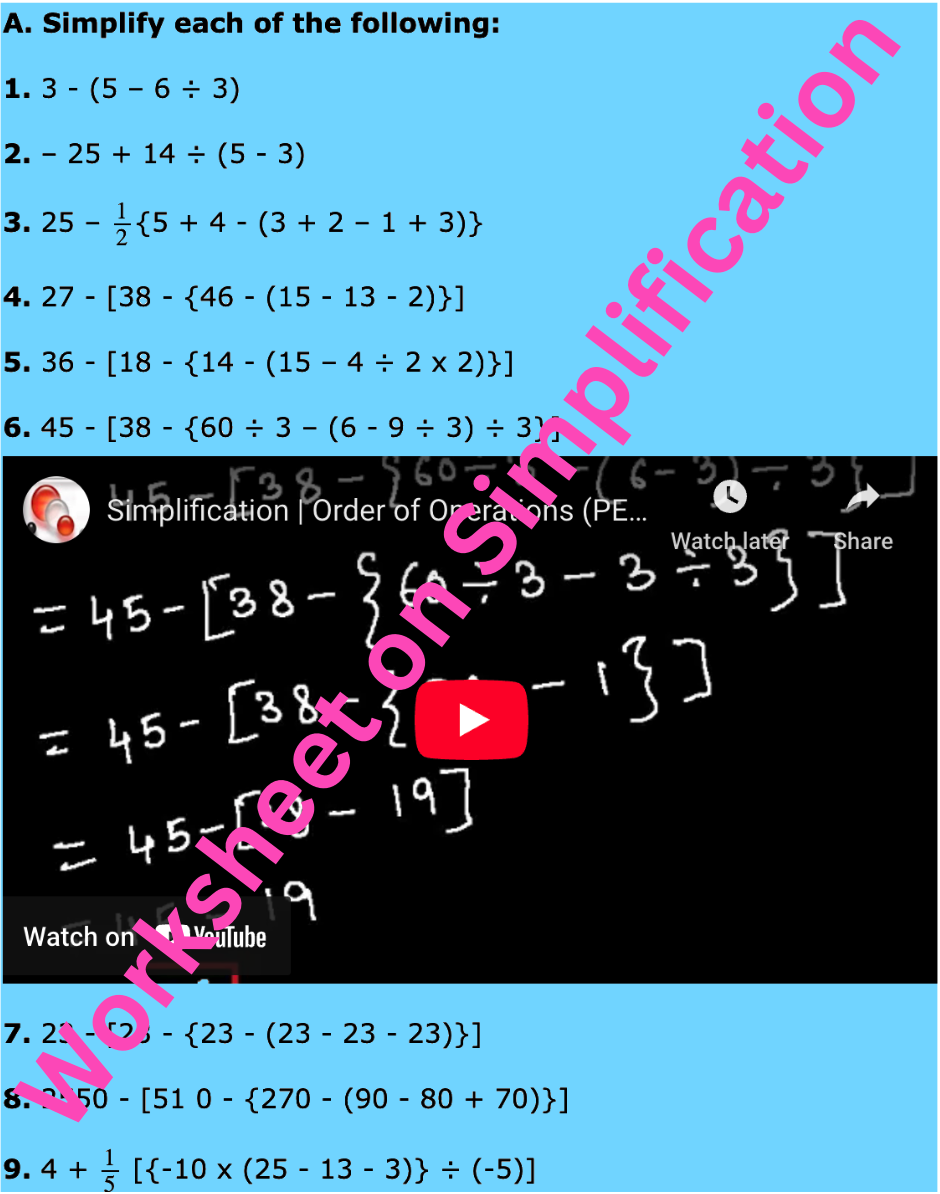Rules for Formation of Roman-Numerals
The Roman numerals system, developed by the Romans thousand of years ago, is based on seven letters of the alphabet. All the numbers are written using either one of the letters or combinations of letters.
The seven letters used in the Roman numeral system.
Each letter has a value when compared with the Hindu-Arabic numerals. Observe the following table:
In rules for formation of Roman-numerals system there is no symbol or digit for zero. This system has no place value system. The digit or digits of lower value is/are placed after or before the digit of higher value. The value of digits of lower value is added to or subtracted from the value of digit of higher value. Using the certain rules for formation of Roman-numerals is given below.
Rule 1: The roman digits I, X and C are repeated upto three times in succession to form the numbers.
(a) We know the value of I = 1, value of X is 10 and value of C is 100.
(b) The value of I, X and C are added as:
|
I = 1 II = 1 + 1 = 2 III = 1 + 1 + 1 = 3 |
X = 10 XX = 10 + 10 = 20 XXX = 10 + 10 +10 = 30 |
|
C = 100 CC = 100 + 100 = 200 CCC = 100 + 100 + 100 = 300 |
(c) No digit is repeated in succession more than thrice, i.e., I, X and C cannot be repeated more than 3 times.
(d) The digits V, L and D are not repeated. The repetition of V, L and D is invalid in the formation of numbers.
Rule 2: (a) When a digit of lower value is written to the right or after a digit of higher value, the values of all the digits are added. As:
|
VI = 5 + 1 = 6 VII = 5 + 1 + 1 = 7 VIII = 5 + 1 + 1 + 1 = 8 XI = 10 + 1 = 11 XII = 10 + 1 + 1 = 12 |
XV = 10 + 5 = 15 XVI = 10 + 5 + 1 = 16 LX = 50 + 10 = 60 LXV = 50 + 10 + 5 = 65 |
(b) Value of similar digits are also added as indicated in rule 1
|
III = 1 + 1 + 1 = 3 |
XXX = 10 + 10 + 10 = 30 XX = 10 + 10 = 20 |
Rule 3: When a digit of lower value is written to the left or before a digit of higher value, then the value of the lower digit is subtracted from the value of the digit of higher value. As:
|
IV = 5 - 1 = 4 IX = 10 - 1 = 9 XL = 50 - 10 = 40 XIV = 10 + (5 - 1) = 14 |
XIX = 10 + (10 - 1) = 19 XXIX = 10 + 10 + (10 - 1) = 29 XLV = (50 - 10) + 5 = 45 CLIX = 100 + 50 + (10 - 1) = 159 |
However, V is never written to the left of X.
Rule 4: (a) If we have to write the numbers beyond 10
we should write the number 10 or groups of number 10 and
then number 1 or 5 as the case may be. Then these numbers are used to change to
the corresponding Roman numerals. As:
12 = 10 + 2 = 1 0 + 1 + 1 = XII
20 = 10 + 10 = XX
22 = 10 + 10 +1 + 1= XXII
26 = 10 + 10 + 5 + 1 = XXVI
39 = 10 + 10 + 10 + (10 - 1) = XXXIX
37 = 10 + 10 + 10 + 5 + 1 + 1 = XXXVII
(b) According to this pattern, numbers higher than number 40 are also formed:
43 = (50 - 10) + 1 +1 + 1= XLIII
56 = 50 + 5 + 1 = LVI
59 = 100 + 50 + (10 - 1) = CLIX
1238 = 1000 + 100 + 100 + 10 + 10 + 10 + 5 + 1 + 1 + 1 = MCCXXXVIII
Rule 5: If a horizontal line is drawn over the symbols or digits of Roman numerals, then the value of the numerals becomes 1000 times. As:
XV = 15 but XV = 15000,CLV = 155 but CLV = 155000
For example:
1. Write the Roman numerals for the following numbers:
(i) 13 = XIII
(ii) 14 = XIV
(iii) 18 = XVIII
(iv) 26 = XXVI
(v) 39 = XXXIX
(vi) 42 = XLII
(vii) 61 = LXI
(viii) 545 = DXLV
(ix) 217 = CCXVII
2. Write the numbers for the following Roman numerals:
(i) VII = 7
(ii) XXXIV = 34
(iii) XXXVII = 37
(iv) XLIII = 43
(v) XLVIII = 48
(vi) LII = 52
(vii) CXL = 140
(viii) CXLV = 145
These are the five rules for formation of Roman-numerals system explained using examples.
REMEMBER: Note that there is no in the Roman system. This system does not use place value to write the numbers
Solved Examples on Rules for Formation of Roman-Numerals:
1. Write in the Hindu-Arabic system.
(i) XXIV
(ii) XXV
(iii) XXXIX
Solution:
(i) XXIV = 10 + 10 + 4 = 24
(ii) XXV = 10 + 10 + 5 = 25
(ii) XXXIX = 10 + 10 + 10 + 10 - 1 = 39
REMEMBER:
Using the symbols I, V, X we can write numbers up to 39.
Roman Numerals up to 39:
|
Hindu-Arabic |
Roman Numerals | |
|
1 2 3 4 5 6 7 8 9 10 11 12 13 14 15 16 17 18 19 20 21 22 23 24 25 26 27 28 29 30 31 32 33 34 35 36 37 38 39 |
I II III IV V VI VII VIII IX X XI XII XIII XIV XV XVI XVII XVIII XIX XX XXI XXII XXXIII XXXIV XXV XXVI XXVII XXVIII XXIX XXX XXXI XXXII XXXIII XXXIV XXXV XXXVI XXXVII XXXVIII XXXIX |
Worksheet on Rules for Formation of Roman-Numerals:
1. Write the answers about yourself in Roman numerals:
|
(i) My date of birth is __________. (ii) l am __________ years old. (iii) The number of the month I was born in is __________. (iv) I study in class __________. (v) My father is __________ years old. (vi) My mother is __________ years old. |
2. Write True or False:
(i) The Roman numerals for 26 is XXV.
(ii) The roman numeral I can be repeated a maximum of three times.
(iii) 34 can be written in Roman numeral as XXXIX.
(iv) The Roman Numeral XXVII represents the number 27.
Answer:
2. (i) False
(ii) True
(iii) False
(iv) True
3. Match the Numbers Column with Roman Numerals Column:
|
Numbers |
Roman Numerals | ||
|
(i) (ii) (iii) (iv) (v) (vi) (vii) (viii) |
19 15 12 8 20 18 30 27 |
(a) (b) (c) (d) (e) (f) (g) (h) |
XXX XVIII XX XXVII XIX XV XII VIII |
Answer:
3. (i) → (e)
(ii) → (f)
(iii) → (g)
(iv) → (h)
(v) → (c)
(vi) → (b)
(vii) → (a)
(viii) → (d)
4. Write the number name for each of the following. Also write the corresponding Hindu-Arabic numeral:
|
(i) (ii) (iii) (iv) (v) (vi) (vii) (viii) (ix) (x) |
XVI VII XXXIV XIV XXXIX XXXV XIX XXXI XXX XVIII |
____________________ ____________________ ____________________ ____________________ ____________________ ____________________ ____________________ ____________________ ____________________ ____________________ |
_____ _____ _____ _____ _____ _____ _____ _____ _____ _____ |
Answer:
4. (i) sixteen → 16
(ii) seven → 7
(iii) thirty four → 34
(iv) fourteen → 14
(v) thirty nine → 39
(vi) thirty five → 35
(vii) nineteen → 19
(viii) thirty one → 31
(ix) thirty → 30
(x) eighteen → 18
Related Concept
● Rules for Formation of Roman-numerals
From Rules for Formation of Roman-numerals to HOME PAGE
Didn't find what you were looking for? Or want to know more information about Math Only Math. Use this Google Search to find what you need.
Recent Articles
-
Counting Numbers from 1 to 50 | Match the Number | Missing Numbers
Apr 04, 25 03:46 PM
In counting numbers from 1 to 50, recognize the numbers, count and then join the numbers in the correct number order. Here we mainly need eye-hand coordination to draw the picture and maintain the num -
Counting Eleven to Twenty with Numbers and Words |Numbers from 11 - 20
Apr 04, 25 03:21 PM
Counting eleven to twenty with numbers and words are explained below. One ten and one more is eleven. Eleven comes after ten. One ten and two more is twelve. Twelve comes after eleven. -
5th Grade BODMAS Rule Worksheet | PEMDAS | Order of operations|Answers
Apr 03, 25 03:11 PM
In 5th Grade BODMAS Rule Worksheet you will get different types of problems on mathematical expressions involving different operations, mathematical expression with 'brackets' and 'of' and simplifying… -
Worksheet on Simplification | Simplify Expressions | BODMAS Questions
Apr 03, 25 02:58 PM
In worksheet on simplification, the questions are based in order to simplify expressions involving more than one bracket by using the steps of removal of brackets. This exercise sheet -
Divisible by 2 Video |Test of Divisibility by 2 Trick| Rules| Examples
Apr 03, 25 10:25 AM
A number is divisible by 2 if the digit at unit place is either 0 or multiple of 2. So a number is divisible by 2 if digit at its units place is 0, 2, 4, 6 or 8.









New! Comments
Have your say about what you just read! Leave me a comment in the box below. Ask a Question or Answer a Question.